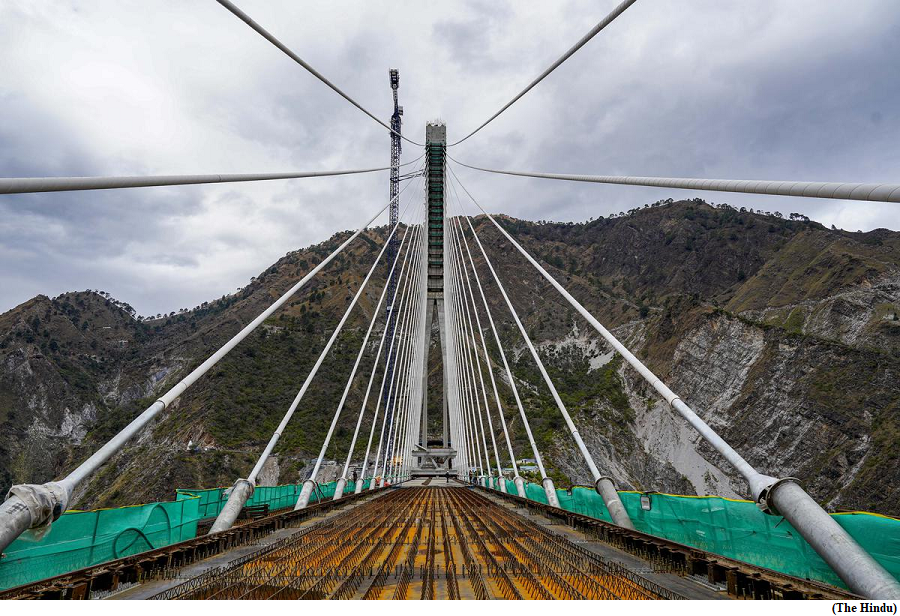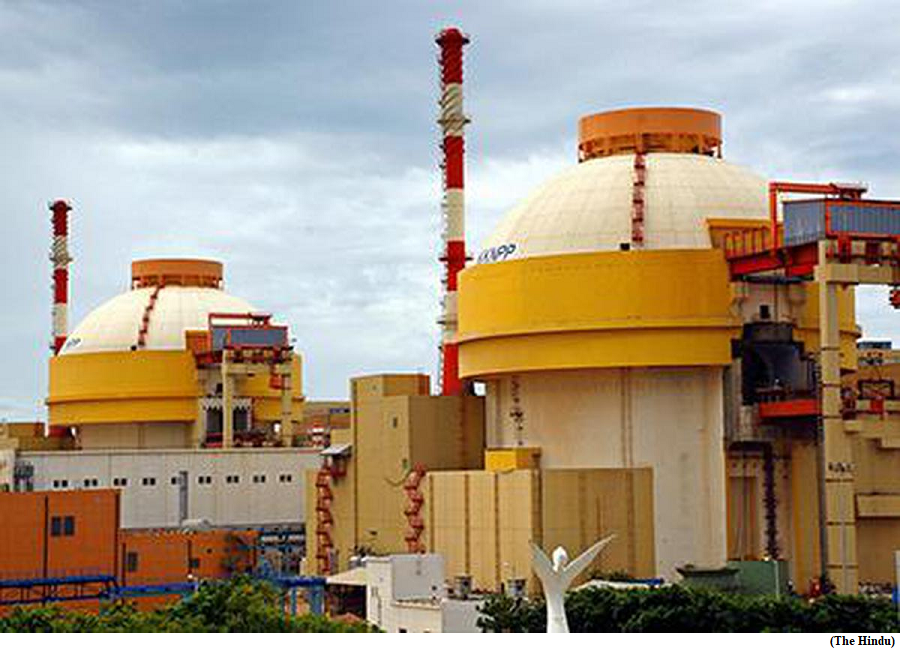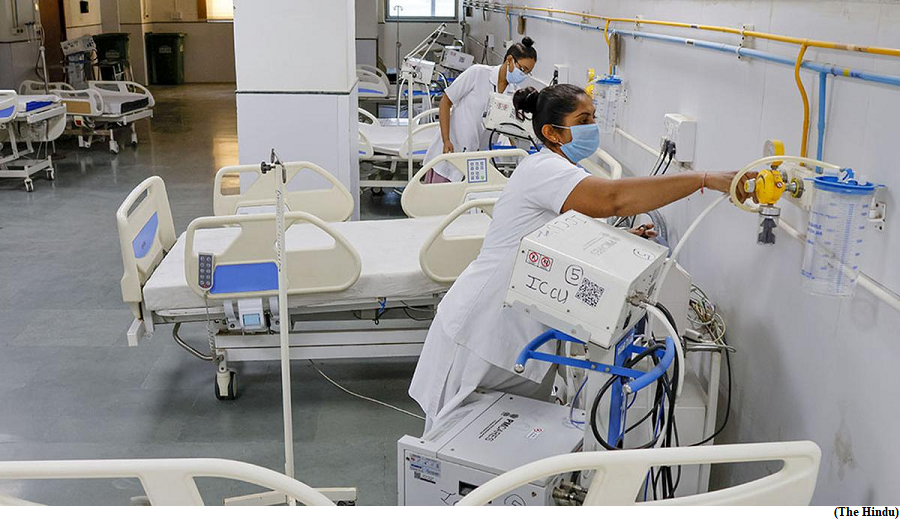India’s first cable-stayed railway bridge nearing completion (GS Paper 3, Infrastructure)

Why in news?
- Twenty years on, the delayed construction of the Anji Khad Bridge in Reasi district of Jammu is a major chink in the Indian Railways’ ambitious plan to connect Kashmir to Jammu and the rest of India seamlessly.
- After missing multiple deadlines, including those in 2017 and 2022, the ₹400-crore project to build India’s first cable-stayed rail bridge is finally nearing completion.
Details:
- Perched precariously over the Anji Khad River that swells every monsoon, the bridge is supported by a single pylon, a large vertical tower-like structure, soaring 1,086 feet from the riverbed, the height of a 77-storey building.
- After the bridge is completed, it will pave the way for a single broad-gauge track for trains connecting Jammu to Baramulla, via Srinagar, along a 326-km railway line.
Challenges:
- The structure of the bridge itself could sustain winds blowing up to 216 km per hour. However, every time the windspeed crosses 45 kmph, construction work, including laying casts, has to be stopped, due to the risk of machinery, like tower cranes, swaying.
- A running train, whose speed limit would be restricted to 30 kmph, can sustain a wind speed of up to 90 kmph.
- However, engineers at the bridge site said that the execution of the Udhampur-Srinagar-Baramulla rail link project, pegged at over ₹37,000 crore, is more challenging due to persistent climatic issues and the treacherous nature of the difficult Himalayan terrain.
Stakeholders:
- The project was commissioned by the Northern Railways and is being executed by Konkan Railway Corporation Ltd. (KRCL) and Hindustan Construction Company.
- Konkan Railway has prior experience of executing the largest railway project of the century in Asia. It cut through ghat sections and built 96 tunnels while laying a 756-km railway line.
Current Status:
- Out of the total length of 326 km, work has been completed on 215 km, including the Jammu-Udhampur-Katra stretch (79 km) on the Jammu side and the Banihal-Qazigund-Baramulla stretch (136 km) in the Kashmir Valley.
- The work on the intervening Katra-Banihal section of nearly 111 km is currently in progress.
- It is the most difficult section of the project, what with construction of 27 tunnels on a stretch of 97 km and 37 bridges in a 7-km section. Nearly 87% of the work is that of tunnelling.
Background:
- The idea was first conceived in 2002 during Atal Bihari Vajpayee’s tenure as Prime Minister, and was declared a “national project”.
- The nearest border area is Suchetgarh, about 92 km from the bridge construction site, making it a politically sensitive project. After 2016, construction work was delayed for a number of reasons, including the Pulwama attack and the onset of COVID-19.
New technique can tell apart spent nuclear fuel from six reactor types
(GS Paper 3, Science and Tech)
Why in news?
- Scientists in China have developed a technique to reliably identify whether some nuclear fuel originated in one of two common kinds of nuclear reactors, a difficult task in nuclear forensics, using experimental data and machine-learning (ML).

Why it matters?
- Nuclear fuel is a highly regulated material because of its destructive potential. Countries maintain detailed inventories to safeguard it.
- Nuclear forensics use analytical methods to identify the origins of nuclear materials and whether they were used for military applications.
- Spent fuel from boiling water reactors (BWRs) is hard to differentiate from that from pressurised water reactors (PWRs) because both “use water as moderator and have similar thermal neutron spectra, so they are quite similar in neutron reaction mechanism.
Basic of the research:
- The group used experimental data instead of simulations, whose accuracy is unknown.
- The reactor type, the fuel’s exposure time inside the reactor, and the extent of the fuel’s enrichment can uniquely identify spent nuclear fuel.
- Using a database that contains the composition of different isotopes in spent fuel from reactors over 50 years, the researchers developed equations that related these quantities to each other.
- If one quantity can be determined through other measurements such as gamma-ray emissions from the spent fuel, the values of the other two quantities can be calculated.
- They also trained data from the database to develop three ML models to distinguish fuel from BWRs from that from PWRs.
- In BWRs, the fuel rods are submerged in water. When the fuel fissions, the water boils and the steam drives a turbine. In PWRs, the fuel rods aren’t exposed to the water; only the heat is exchanged.
Outcome:
- The group’s ML models correctly identified 91% of the fuel from BWRs, and 95% the of fuel from PWRs.
- There was no explicit information about the accuracy of discriminating between PWRs and BWRs in older papers.
Should India worry about rising COVID-19 cases?
(GS Paper 2, Health)
Why in news?
- Recently, the Prime Minister convened a high-level meeting of the COVID-19 taskforce.
- This is the first time this year that such a meeting has been convened, with the last such meet held on December 22, 2022.

Why was the meeting necessary?
- By all metrics, there has been a rise in COVID-19 cases over several weeks. As of March 23, India officially reported 1,300 new coronavirus cases over a 24-hour period bringing the overall tally of active cases to 7,605. In the previous weeks too, an average of 800 cases have been reported weekly.
- The death toll climbed to 5,30,813 with five deaths, one each reported in Chhattisgarh, Delhi, Gujarat, Maharashtra and Kerala. The number of daily deaths has been in the single digit in the past few weeks. Globally, about 1 lakh cases are being reported every day.
- The daily positivity rate, or the percentage of tests administered by States every day that confirms the presence of the virus, was recorded at 1.46% while the weekly positivity rate was pegged at 1.08%.
- During the pandemic, a test positivity rate below 5% was considered to be a sign of the disease being within manageable limits.
What was the outcome of the meeting?
- PM said that the COVID-19 pandemic “is far from over”, and he stressed the need to monitor the status of the disease across the country on a regular basis.
- He directed officials to increase whole genome sequencing of COVID positive samples, using the designated INSACOG (Indian SARS CoV-2 Genomics Consortium) laboratories, to aid with the tracking of new and emerging variants and facilitate a timely response.
- The consortium is a network of labs across the country that analyses samples from different regions and sounds an alert if a spike in cases is linked to certain mutations of the coronavirus that are known to increase virus transmissibility.
- He directed officials to follow up with States to ensure effective monitoring of all cases of influenza-like illnesses (ILI) and severe acute respiratory Illnesses (SARI), with testing for influenza, SARS-CoV-2 and adenovirus.
What is behind the surge in cases?
- There is an increase in the number of seasonal influenza H3N2 cases and tests on patients often reveal an uptick in COVID-19 cases.
- A rapidly proliferating lineage of the Omicron virus called XBB.1.16 is believed to be behind the recent spike in COVID-19 cases.
- Scientists from the INSACOG consortium report that though systematic genomic surveillance in India is limited, XBB.1.16 has been found in nearly a third of all the sequenced genomes in March 2023.
- Its proportion has been seen to be increasing in the past few weeks, to become the major lineage in several States such as Telangana, Maharashtra, Karnataka, Gujarat, Delhi, Puducherry, Haryana, Himachal Pradesh, and Odisha. These States report higher cases also because they have better surveillance systems.




